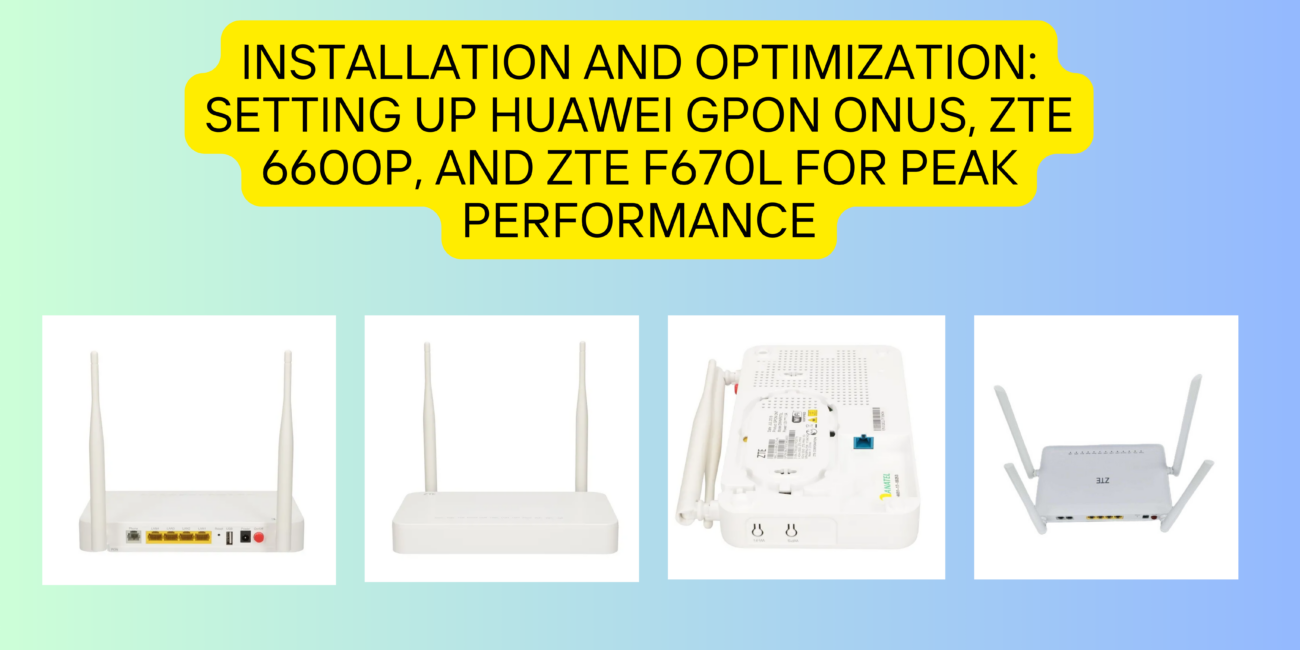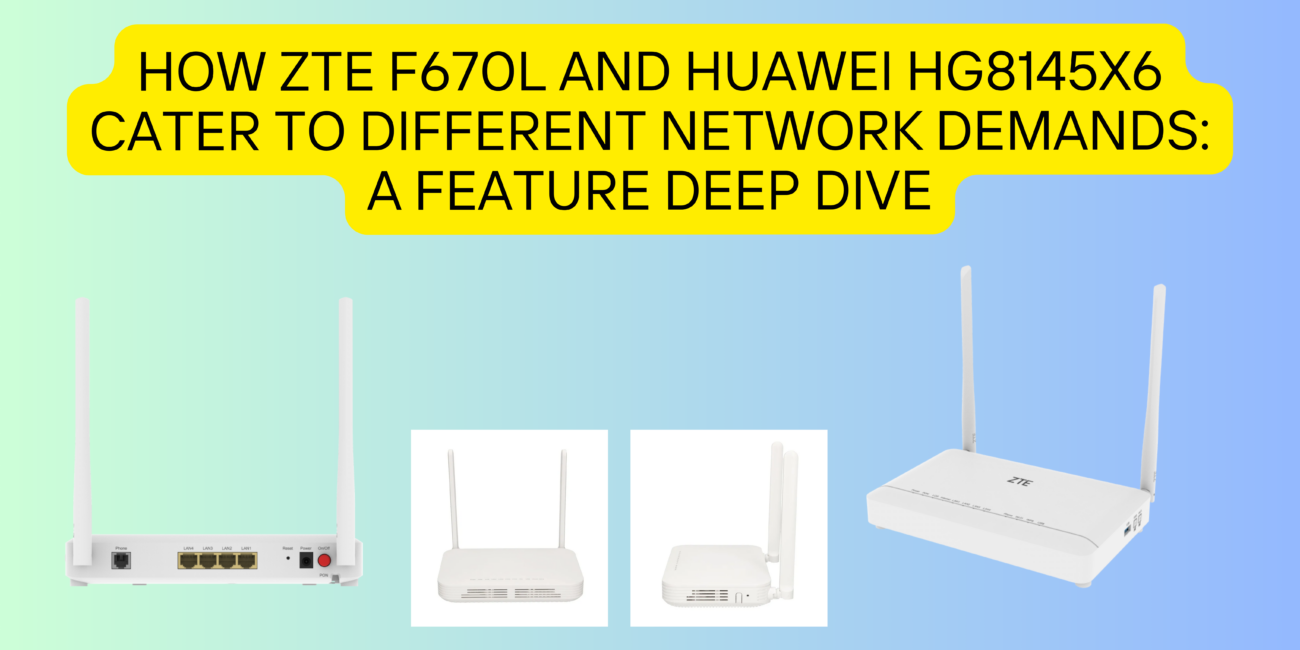In the realm of networking technology, Optical Network Units (ONUs) play a pivotal role in facilitating high-speed internet connections to homes and businesses. Two prominent players in this arena are ZTE and Huawei, both renowned for their innovative hardware and firmware solutions. Today, we delve into the intricate world of ONU firmware, particularly comparing the firmware of two popular models: the Huawei HG8245H and the ZTE F670L.
Understanding ONU Firmware:
Before we embark on the comparison journey, let’s grasp the essence of ONU firmware. Firmware, in simple terms, refers to the software embedded within the hardware of an ONU. It serves as the operating system, governing the functionality, performance, and security of the device.
ZTE vs. Huawei: The Basics:
ZTE and Huawei, two giants in the telecommunications industry, offer ONUs with distinct firmware architectures. While both aim to deliver reliable connectivity, they often employ different strategies and features in their firmware implementations.
Huawei HG8245H Firmware:
The Huawei HG8245H is a widely used ONU known for its robust performance and feature-rich firmware. Huawei’s firmware typically emphasizes user-friendly interfaces, extensive customization options, and advanced security measures. The HG8245H firmware boasts a sleek graphical user interface (GUI), making it easy for users to configure settings and monitor network activity.
One of the standout features of Huawei firmware is its extensive QoS (Quality of Service) capabilities. This enables users to prioritize network traffic based on application requirements, ensuring optimal performance for critical services such as VoIP or video streaming.
Additionally, Huawei firmware often includes built-in diagnostic tools and remote management capabilities, empowering network administrators to troubleshoot issues efficiently and perform remote maintenance tasks.
ZTE F670L Firmware:
On the other hand, the ZTE F670L brings its own set of strengths to the table with its firmware. ZTE’s approach to firmware design typically focuses on stability, scalability, and interoperability. The F670L firmware may not feature as flashy a GUI as Huawei’s counterpart, but it excels in reliability and performance.
ZTE firmware prioritizes seamless integration with various network environments, ensuring compatibility with a wide range of third-party devices and software solutions. This flexibility makes the F670L a popular choice for service providers and enterprises seeking a reliable ONU solution.
Moreover, ZTE firmware often incorporates advanced security protocols and encryption mechanisms to safeguard against potential cyber threats, providing users with peace of mind regarding their network’s integrity.
Comparative Analysis:
When scrutinizing the firmware of the Huawei HG8245H and the ZTE F670L, a nuanced examination reveals a myriad of distinctions and overlaps that underscore the unique approaches taken by these telecommunications juggernauts.
- User Interface: The user interface serves as the gateway to the functionality and configurability of an ONU’s firmware. Huawei’s firmware sets itself apart with a visually captivating and intuitively designed interface on devices like the HG8245H. The graphical user interface (GUI) of the HG8245H firmware boasts vibrant visuals, intuitive navigation menus, and interactive elements, making it accessible even to novice users. In contrast, ZTE’s F670L firmware adopts a more minimalist approach, prioritizing simplicity and functionality over flashy aesthetics. While lacking the visual flair of its Huawei counterpart, the F670L interface is straightforward and efficient, catering to users who prefer a no-frills experience.
- Feature Set: Both Huawei and ZTE firmware offer a rich assortment of features geared towards enhancing network performance, security, and manageability. The Huawei HG8245H firmware, renowned for its comprehensive feature set, encompasses a wide array of functionalities such as Quality of Service (QoS) management, VLAN configuration, firewall settings, and port forwarding capabilities. Moreover, Huawei’s firmware often incorporates advanced technologies like Dynamic Bandwidth Allocation (DBA) and Traffic Engineering (TE), enabling fine-grained control over network resources and traffic optimization. In comparison, ZTE’s F670L firmware boasts similar core functionalities but may prioritize certain features differently. For instance, ZTE firmware may excel in areas such as multicast support, IPv6 compatibility, or network bridging configurations, catering to specific use cases or industry requirements.
- Stability and Reliability: Stability and reliability are paramount considerations in the selection of ONU firmware, especially in mission-critical environments where downtime is not an option. ZTE firmware is lauded for its rock-solid stability and robustness, underpinned by rigorous testing and quality assurance processes. The F670L firmware is engineered to deliver consistent performance under varying load conditions, ensuring uninterrupted service for end-users. On the other hand, while Huawei firmware exhibits commendable reliability, it may necessitate more frequent updates and patches to address vulnerabilities or optimize performance. This could be attributed to Huawei’s emphasis on introducing cutting-edge features and functionalities, which may inadvertently introduce complexities or stability concerns.
- Customization Options: The ability to customize firmware settings according to specific requirements is a key consideration for network administrators and service providers. Huawei firmware, known for its extensive customization options, empowers users to tailor settings and configurations to suit their unique needs. Whether it’s fine-tuning QoS parameters, implementing access control policies, or configuring network protocols, the HG8245H firmware offers granular control over various aspects of network management. Conversely, ZTE firmware, while less flexible in terms of customization, emphasizes compatibility and interoperability across diverse network environments. The F670L firmware may offer standardized configurations and deployment methodologies, streamlining the integration process and facilitating scalability.
In essence, the comparison between Huawei HG8245H and ZTE F670L firmware underscores the divergent philosophies and priorities adopted by these industry leaders. While Huawei excels in delivering feature-rich firmware with a user-centric approach, ZTE distinguishes itself through its steadfast commitment to stability, reliability, and interoperability. Whether you prioritize intuitive user interfaces, extensive feature sets, rock-solid stability, or seamless interoperability, both Huawei and ZTE firmware offer compelling solutions tailored to meet the evolving demands of modern networking environments.
Conclusion:
In conclusion, both Huawei and ZTE offer formidable ONU solutions with firmware tailored to meet the diverse needs of modern networking environments. While Huawei firmware shines with its user-friendly interface and extensive feature set, ZTE firmware excels in stability, reliability, and interoperability.
Ultimately, the choice between Huawei and ZTE firmware boils down to individual preferences, specific use cases, and organizational requirements. Whether you opt for the Huawei HG8245H or the ZTE F670L, rest assured that you’re investing in a reliable and feature-rich ONU solution backed by two industry-leading telecommunications giants.


